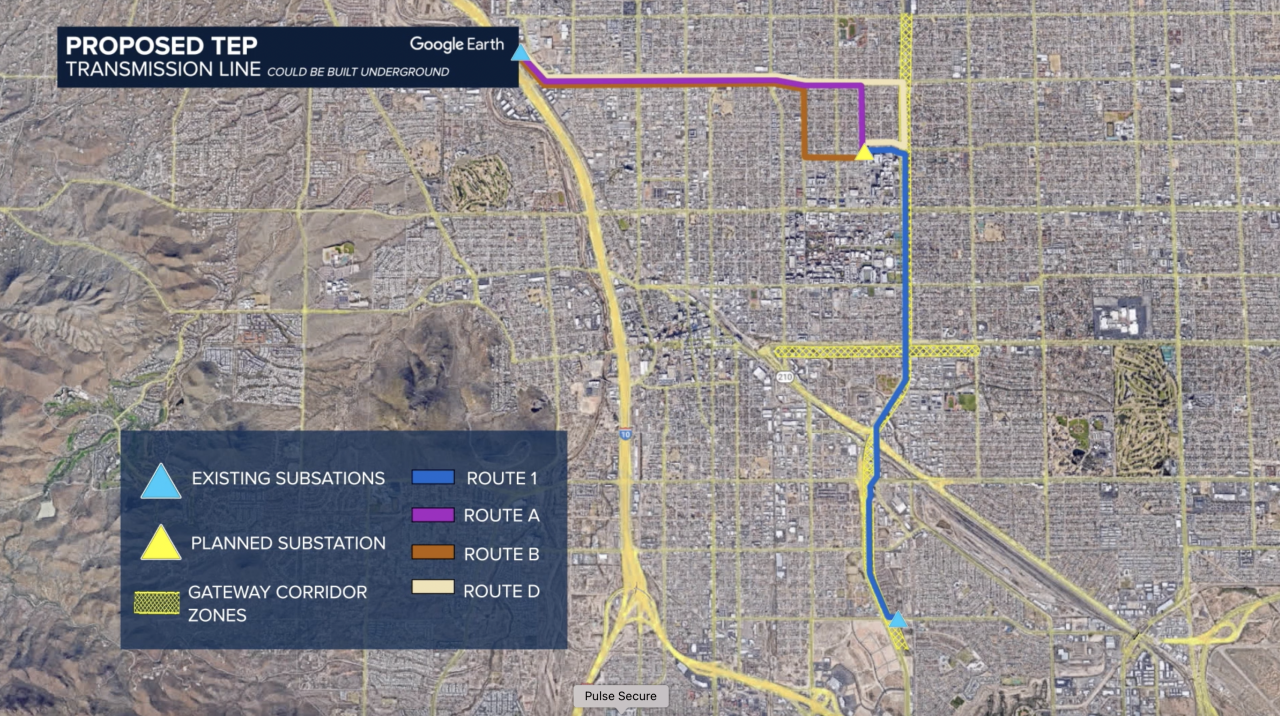TUCSON, Ariz. (KGUN) — On May 16, Tucson voters will decide in a special election whether to approve a new agreement between Tucson Electric Power and the city.
The utility says it needs to build better infrastructure to keep the lights on in the future, but customers within the city limits would have to pay more.
TEP’s new plan aims to build a transmission line connecting its substation at Kino Parkway and 36th Street to another near I-10 and Grant Road, in order to improve the grid in Central Tucson. It would also add a new TEP substation along the route, just west of the Banner UMC campus.

To do so, TEP would a 0.75% “resilience fee” as part of a new franchise agreement with the city.
That would be in addition to the existing 2.25% fee for customers within the city limits, a number set by the current franchise agreement, which expires in 2026.
How much is the proposed increase?
The 0.75% increase, TEP says, would add about $1 to monthly bills for average residential households, though a spokesperson clarified that households that use more energy would see bigger increases.
Given typical energy consumption, commercial buildings would see a bigger monthly increase.
However, TEP says the improvements—and rate hike—are necessary in the Midtown area.
What are the proposed improvements?
“What we’ve seen in some individual circuits is equipment that is nearing the end of its useful life, circuits that are at or near capacity,” said TEP spokesperson Jospeh Barrios.
TEP says the proposed higher voltage, higher capacity transmission line would fix that issue — and help the neighborhoods all along it.
The most likely path will use Kino Parkway and North Campbell Avenue, but the exact route has not yet been determined and several options are still “in the mix.”
“The more interconnections that we have, the greater flexibility we have to get the lights back on in the event of an outage,” said Barrios, clarifying that all the neighborhoods surrounding the project will be in a better position if it is approved.
Why is TEP planning to build some of the transmission line underground?
People in Sam Hughes, Jefferson Park and other neighborhoods near the proposed route have rallied against above-ground power lines, saying they should not run through the historic neighborhoods.
Ward 3 council member Kevin Dahl says others report safety concerns, including a potential risk for helicopters arriving at Banner UMC.
Because of those concerns, TEP now plans to build some to-be-determined sections of the line underground.
Doing so, Barrios admits, makes the project “significantly more costly” than installing power lines overhead. He says the company is still taking input from people impacted by the project.
What about areas outside of Midtown, but still near the project?
Cindy Ayala, president of the Pueblo Gardens Neighborhood Association, wants to see grid improvements in her neighborhood but has been frustrated with the process.
She feels like those protesting thee above-ground poles have held up the project and now are forcing everyone else to pay for an unnecessary underground transmission line. She says she would vote ‘No.’
“No, I’m not willing to raise my TEP rates, just so you can put this [underground line in] and satisfy a bunch of people,” she told KGUN Thursday.
Ayala also feels like her neighborhood and others and the South Side are often overlooked and that TEP does not take them seriously.
One of the transmission line routes still under consideration runs through the neighborhood’s cherished central median along South Campbell Avenue.
Ayala still wants to see TEP make improvements. She says rapid development of hotels, restaurants and office buildings at the UArizona Tech Park on Kino have led to a strain on the area’s power, and led to more frequent brownouts.
“I am all for everything that’s coming in, but we are all on the same electricity grid,” she said. “We need the boost. We need the power… We’re the ones that have to replace our own electronics. Do they [TEP] want the bill?”
Where else would the money go?
Climate advocates are watching the special election closely. If passed, the agreement would allocate about 10 percent of the new fee’s revenue to the city’s climate change initiatives over the next 10 years, before revisiting the distribution.
When asked why the project cost is being passed on to TEP customers in the city, Barrios pointed to the climate change initiatives as one way the money will impact everyone. He also told KGUN that TEP is careful with the costs it incurs, because those eventually get passed down to customers.
“It’s important to remember that when customers pay their monthly bills, they are paying for the cost of not just the fuel to generate the energy that they use, but also for the repair, maintenance and upgrades of our equipment,” he said.
——-
Ryan Fish is an anchor and reporter for KGUN 9 and comes to the Sonoran Desert from California’s Central Coast after working as a reporter, sports anchor and weather forecaster in Santa Barbara. Ryan grew up in the Chicago suburbs, frequently visiting family in Tucson. Share your story ideas and important issues with Ryan by emailing ryan.fish@kgun9.com or by connecting on Facebook and Twitter.



